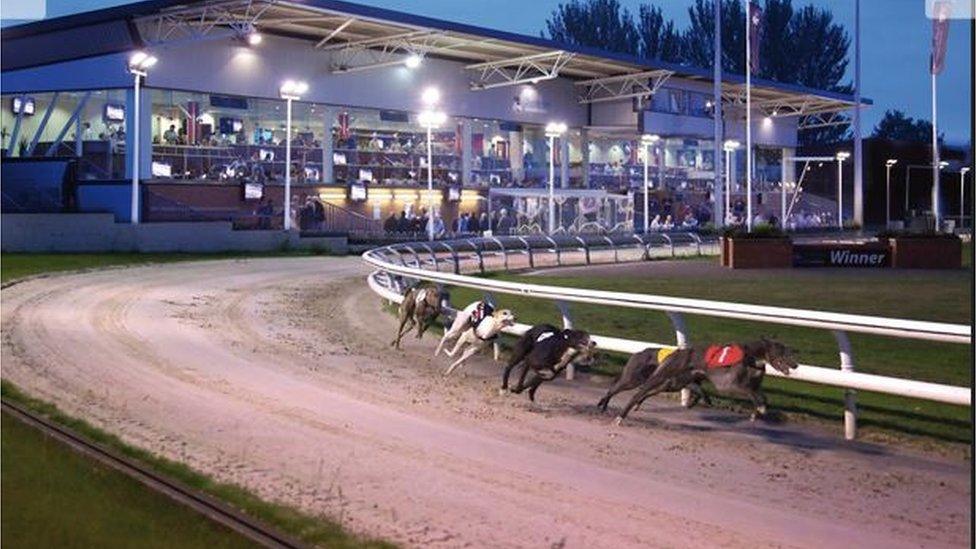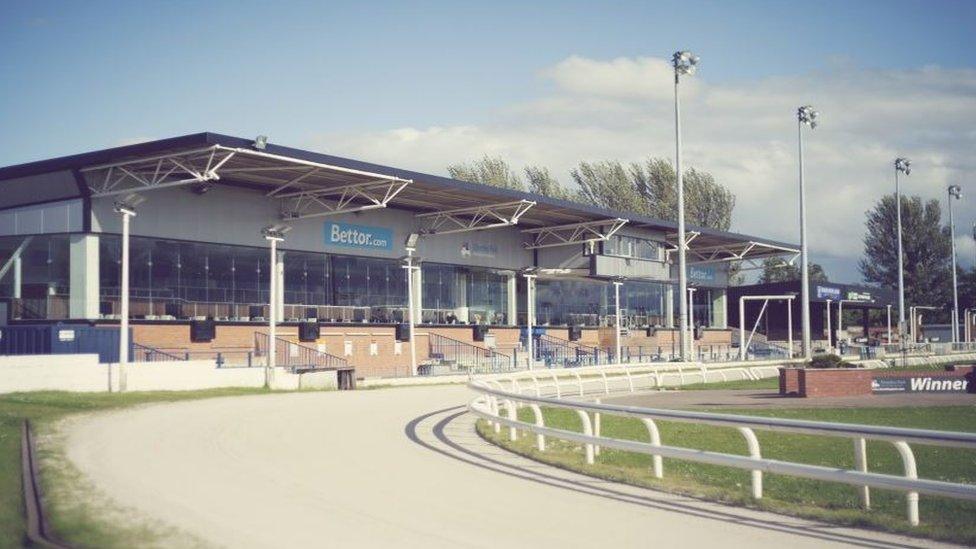Greyhound racing: A potentially profitable, risky business
- Published

On Tuesday, the Irish trainers of a kidnapped greyhound expressed relief at finding him safe and well.
Little wonder when you consider that Clares Rocket is believed to be worth up to 1m euros (£847,000) in stud fees.
So how profitable an industry is dog racing for those involved in it?
According to the manager of Drumbo Park in Ballyskeagh, County Down, it's a potentially lucrative but risky business, and the risk is increasingly shared between multiple owners.
"A lot of people go in for joint ownership now," said John Connor, who is one of only two dog racing managers in Northern Ireland.
"That way they can spread the cost and the risk as it can be very costly, not just buying the dog, but the investment that it takes after that to train and promote."
In a racing capacity, good money can be earned from the performance of greyhounds during their track career, but a strong stud prospect is "what all breeders dream of" Mr Connor said.

Drumbo Racecourse is one of only two in Northern Ireland
However, it's a prospect that's not always easy to predict.
"Some people invest a lot of money in promoting stud dogs that don't make it," Mr Connor said.

Famous names
Master McGrath was born in County Waterford, Ireland.
A small, weak pup, he went on to become the most celebrated and successful dog of his time.
Born in 1866, at his first trial the dog showed none of the outstanding qualities that were later to make him famous.
In fact, his performance was so bad that his trainer arranged for him to be given away.
However, the "slipper" (handler) who took charge of him had more faith in him, entering him in several courses, which he won.
After these wins, he was returned to his trainer and won the Waterloo Cup on three occasions - 1868, 1869 and 1871 - the first greyhound to do so.
He became such a celebrity that his owner, Lord Lurgan, was asked to take him to be seen by Queen Victoria and the British Royal Family. A bronze sculpture of of the dog still stands in Lurgan town centre.
Mick The Miller is another of the most famous greyhounds of all time. The first great track star, he was a household name in the UK and Ireland during the period before WWII.
Mick moved the sport of greyhound racing from coursing to track. Owned by a priest and then sold to England, where he won two greyhound derby crowns and controversially nearly won a third. He became a film star and eventually an exhibit in a museum.
Ballyregan Bob was a brindle dog and was born in 1983, bred by Robert Cunningham of Ballagh in Ireland.
He joined George Curtis at Brighton after just one race and victory in Ireland. He lost his first four races in England but then won eight in a row by the end of 1984.
In 1986 the sport was buzzing from the incredible record set by Ballyregan Bob who had captured the public's attention, leading to a rise in attendances.

"Breeders can be quite fickle - if they don't see good pups coming through at an early stage, they'll move on to a different dog."
Although there are no greyhounds of Clares Rockets' stature in Northern Ireland at the moment, 'I'm Slippy', bred in Limavady, County Londonderry, was the top stud dog in the UK and Republic of Ireland in the 1980s and his bloodline continues to thrive.
"He was huge in the 80s, but his lines [offspring] are coming through even now, and they they also brought great profits for their owners," Mr Connor said.
John, who has "racing in the blood", still remembers the thrill of watching 'I'm Slippy' as a five-year-old child.
"He was just exceptional to watch. Dogs like that don't come around too often," he said.

Drumbo does not receive government funding like some Republic of Ireland racecourses, so it survives on ticket sales and corporate sponsorship
For the Hannahstown man, the love of the sport comes from his family: "A lot of people in the industry are second and third generation, we grew up with it."
Mr Connor believes the sport has a unifying force that some other sports lack.
"It gives the ordinary man the chance to compete on a level and it goes above religion, politics, culture and class structures," he said.
"In Drumbo, you'll see people from the Falls sitting alongside people from the Shankill or wherever, treating each other with respect, willing each other on. There's no division like you sometimes see in football."
The first track racing in Ireland was held on Easter Monday 1927 at Celtic Park, near the Falls Road in west Belfast.
Despite this early promise, the industry didn't thrive in the way that it did in the Republic and today there are only two greyhound stadiums in Northern Ireland.
Part of the problem is that neither is licensed by the Greyhound Board of Great Britain (GBGB) or the Irish Greyhound Board (IGB), so they rely on ticket sales and corporate sponsorship to survive.
By contrast, in the Republic of Ireland, greyhound racing was successfully transformed a number of years ago into a sociable as well as a sporting occasion and the IGB will receive around 16m euros in government funding next year.
"They get all their prize money in grants and subsidies, but we have to supply it all ourselves," Mr Connor said.
"It would be great if we could all compete on a level playing field, but I don't think that's going to happen here. It's definitely a more profitable industry in the south."